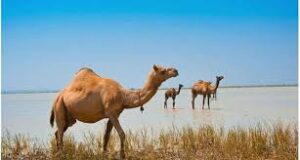Prelims Bits

Context:
A herd of 33 Kharai camels from Singach village, Gujarat, was swept into the Arabian Sea tide near Jamnagar, while grazing on mangrove forests.
About Kharai Camels:
- Breed Overview:
The Kharai is a rare camel breed known for its ability to swim and survive in saline and marshy habitats — making it unique among camelids. - Recognition:
It is India’s 9th recognized camel breed, specially adapted to Gujarat’s coastal zones.
Habitat and Geographic Range:
- Native Regions:
Found in Kutch, particularly in Bhachau, Abdasa, Lakhpat, and parts of Devbhoomi Dwarka and Jamnagar. - Population:
Approximately 4,000 camels exist in Gujarat, with nearly 2,000 in coastal Kutch. - Habitat Behaviour:
These camels swim across shallow seawater to access mangrove islands for grazing.
Cultural and Social Importance:
- Pastoral Communities:
Primarily reared by Rabari and Fakirani Jat groups, under the traditional Maldhari pastoral system. - Etymology:
‘Kharai’ comes from the Gujarati word ‘khara’ meaning salty, indicating its habitat preference.
Unique Biological and Behavioural Traits:
- Swimming Capability:
Can swim up to 3 km in the sea — a rare trait among camel breeds. - Physiological Adaptation:
Can digest saline vegetation, unlike other camels. - Breed Type:
Dromedary (single-humped), weighing up to 500 kg, with strong build and high endurance. - Seasonal Migration:
Migrate to mangrove islands during the monsoon, staying there for extended periods. - Diet:
Specialises in feeding on mangrove foliage.
Significance and Conservation Value:
- Ecological Role:
Helps sustain the delicate coastal ecosystem through regulated grazing practices. - Cultural Heritage:
Represents the traditional knowledge and resilience of Gujarat’s nomadic communities. - Climate Adaptability:
Serves as an example of climate-resilient livestock, essential for sustainable and climate-smart agriculture.




